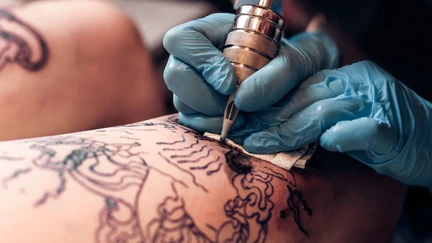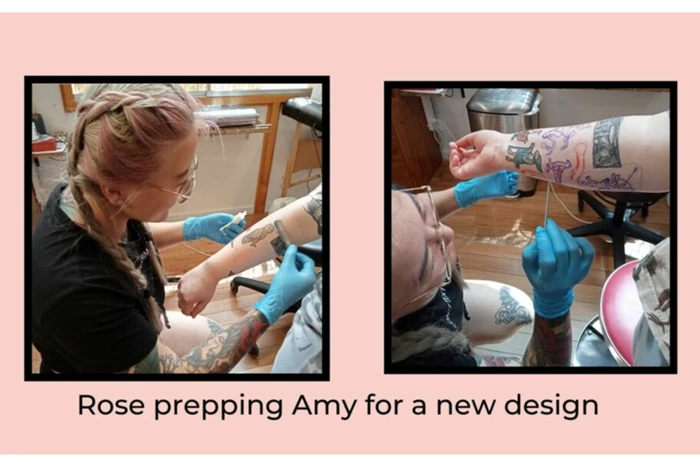Skin deep: Talking about tattooing in Wellington, Part 1
Part 1 of our series on tattooing in Wellington.

"Show me a man with a tattoo and I'll show you a man with an interesting past"
- Jack London
The art of tattooing has a long history. Tattooing was common in Celtic cultures, indigenous communities of the Americas, throughout Asia and of course the peoples of the Pacific.
In this two-part blog we look at the history of commercial tattooing in Wellington, modern day tattooing businesses, regulatory standards and legislation relating to the industry and rights associated with employment. This blog does not cover traditional or cultural tattooing practices however resources relating to this will be referenced in our resource list at the end of the blog.
More than 100 years ago tattooists were offering their services from premises throughout the Wellington business area. The electric tattoo machine was patented in the early 1890s and within 20 years tattooing via machine was being advertised to Wellingtonians.
Read this brief history of commercial tattooing in Wellington to learn more.
Tattooing went rock 'n' roll in the late 1960s and early 70s, a time also marked by the counterculture and protests against the Vietnam war. In Britain legislation was passed in 1969 making it:
... an offence to tattoo a person under the age of eighteen except when the tattoo is performed for medical reasons by a duly qualified medical practitioner ...
Attempts to introduce similar legislation in New Zealand were unsuccessful.
Reporting at the time noted there were no regulations governing the operation of professional tattooists in New Zealand, they required no licence, nor did the methods or materials come under any health regulations. It further noted there were only two professional tattooists in Aotearoa at the time.
Today there are at least 14 tattoo businesses clustered in the vicinity of Cuba-Willis-Vivian Street. Rogers Tattoo Art in Cuba Street is Wellington's longest running tattoo business having been in operation since 1977.
At a recent tattoo expo held in New Plymouth over 250 tattooists from throughout the country, along with international guests, showcased their artistry.
As we move into more modern times keep this social history in mind as we will return to some aspects of it further on.
"Believe it or not, some of us have piercings and tattoos and dye our hair because we think it looks pretty, not for any deep sociological reason"
- Alex Bell, The Ninth Circle
We're now going to meet Amy.
Amy is one of numerous Wellington City Libraries staff sporting tattoos (visible or otherwise).
Amy got her first tattoo at 15, with parental consent (a point we will return to in Part 2 of this blog). She has since gathered other designs signifying different life stages or just because “they looked good”.
Presently Amy is getting a series of fantastical creatures inked on her right forearm.
Based on illustrations from medieval themed manuscripts Amy intends to eventually have a sleeve of designs. She’s done her research using art books from the library as well as internet design sites. For her the art works are personal for herself and this is the first piece that has been prominently on display.
Whether Amy realises it or not she is one of a young tattooed demographic.
A much quoted survey conducted around 2009 found one in five New Zealanders have a tattoo and for those under 30 years of age, the statistics become 1:3. This should be no surprise to anyone who frequents any of the city’s cafes and bars.
Amy chose Rose Hu at Buttercat studios in Cuba Street's Left Bank after seeing examples of her work online and following her social media for a while. An owl design among Rose's flash (ready to tattoo designs) drew Amy's attention and she booked a consultation. That was the beginning of an ongoing piece.
As an artist Rose’s work focuses on the cute and colourful. Her belief is that tattoos are an ultimate expression of agency and empowerment and aims to create a tattoo experience centred around these ideas. You can see more of Rose’s work on Instagram.
Rose has been a qualified tattoo artist for a number of years and says everyone’s motivation to get a tattoo is different. On finding a design, Amy emails it through to Rose who then draws it up, a layout is decided on consultation, photographed and then, over subsequent sessions the designs are etched onto Amy's arm.

Of all Amy's tattoos she is disappointed with one of her early ones as she feels the quality is not up to the standards she now expects. She is considering her options regarding altering and reworking of this piece.
Kat from Sinatra’s tattoos specialises in laser removal of tattoos and is believed to be the only laser removal specialist operating from a local studio.
She has been doing laser removal for six years after first starting out doing cosmetic tattooing. When a colleague who had previously done the laser removal work moved on he trained Kat to take over.
The four main reasons people consult Kat seeking tattoo removal are (in no particular order) :
- Fashion changes
- Visible placement
- To remedy or remove poor workmanship
- Partner changes
Not everyone wishes to have all traces of a tattoo removed. Some use the laser process to alter an existing tattoo in order to have it reworked and care is needed to prepare the skin (or canvas) so it is suitable for tattooing again, a process Amy is considering.
The process can be a long, slow, and sometimes painful one with work usually done in 30-minute sessions. Depending on the complexity anywhere between 3-4 (cover up) and ten or more (removal) sessions may be required.
Kat’s advice is to carefully consider the consequences of the design and placement.
Although name removals are regularly requested, Kat does a lot of facial work “… I see a lot of people who have left prison and are now wanting a fresh start. I’m helping them remove [their tattoos] and change their lives. It’s something I enjoy the most about my job”.
Even in the short time Kat has been doing removal work she has seen changes. More younger people are requesting removal of fresh tattoos, something she finds sad.
"If I could do anything in the tattooing world it would be … to advise you to do your homework. Do your homework on the artist …. [and] think carefully about the meaning of the tattoo … and really think about placement”
Read more in part 2 of this blog here
Reading list
- Wearing ink : the art of tattoo in New Zealand by Dean Johansson
- The art of the New Zealand tattoo by Anne Nicholas
- New Zealand tattoo : in the home of the tattooist's art by Chris Hoult
- Juxtapoz : tattoo
- The tattoo encyclopedia : a guide to choosing your tattoo by Terisa Green
- Art on skin : tattoos, style, and the human canvas by Nancy J. Hajeski
- Customizing the body : the art and culture of tattooing by Clinton Sanders